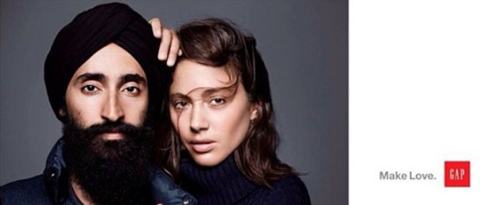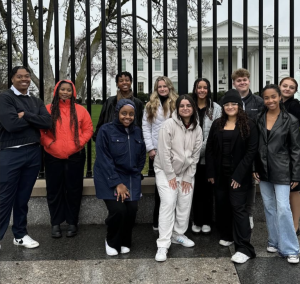If there were ever a microcosm of upper-middle class American consumerism, it’s Park Avenue. Complete with high end boutique stores such as Alex and Ani that sell bracelets and bangles at $45 a pop and restaurants such as Luma, one could argue that this is where “the other half” shops and dines. While the Gap on the corner of Park next to Starbucks is certainly not exclusively limited to clothing the wealthy, it does not scream the word “diversity.”
This is why I was caught off guard when stepping out of Powerhouse Café (tabbouleh and hummus in hand, no less) to see a large ad campaign featuring a Sikh man complete with a turban and beard modeling next to a gorgeous, presumably Middle Eastern or Indian woman. I was intrigued. The Gap brand has always been that of capturing the quintessential essence of Americana embodied by white, black and Asian Americans, even putting forth philanthropic efforts with their noteworthy Red campaign which directly benefits the Global Fund to Fight Aids, Tuberculosis and Malaria. However, never has the Gap put forth a campaign that ventured toward any stance or possible statement regarding the precarious territory that surrounds religion, especially a non-Christian denomination in a predominantly Christian nation.
Naturally, I went inside the store to ask if their campaign was for a bigger cause. I was met with frank indifference by the store manager, who clearly thought I was a racist. My inquiring as to if there was a specific reason that a Sikh man be featured in the ad campaign was met with the icy rebuttal of “Our theme for the campaign is textured and cozy knits for the holiday season.” Textured and cozy knits? I continued, asking if the Sikh man was a prominent religious leader or celebrity. He looked at me with mild disgust and retorted, “He’s just one of our models, ma’am.” At that, he promptly turned and began folding his textured, cozy knits. Have we become so terrified of coming off as politically incorrect that we have chosen to ignore diversity altogether? My questions were not from a place of hatred, but from the understanding of the reality that we do live in a racially charged society and many Americans garner misguided feelings of suspicion toward anyone who appears to be Middle Eastern or Muslim. Furthermore, I pictured the reaction the ad must be rendering in stores worldwide where the turban is forbidden, not to mention recent national headlines of individuals writing racial slurs on the ad itself.
The campaign coincides directly with an increased trend of violence against Sikhs in the US. Just this past September, Columbia University Professor Prabhjot Singh, a Sikh man who lives in Harlem, was attacked by a group of young men. While Singh sustained punches to his face and upper body, they shouted “get Osama” and “terrorist.” The attack received rampant media coverage and was labeled a “mistaken identity” hate crime, because it was actually intended for a Muslim. I have two issues with this. One, that this blatantly points out the ignorance of Americans to believe that Sikhism is a sect of Islam and incorrectly associate all turbans with Osama bin Laden. In fact, a study released in September by Stanford University indicated that 70 percent of Americans mistake all turban-wearers for Muslims. Second, the term “mistaken identity” suggests that there is a respectable target for hate crimes. The hate crime would not have been any more justified had Singh been in fact, Muslim.
I clearly wasn’t going to get any substantial information from the employees at the Gap. I first searched the Gap website and did not find the turbaned man anywhere, only pictures of perky white men and women jumping in their sweaters and slim fit jeans. If the Gap was supposedly putting out a national ad campaign promoting diversity, wouldn’t they post such information on their website?
After additional research, I learned that the elusive man in the turban is acclaimed actor/designer/model Waris Ahluwalia. Ahluwalia was born near Punjab, India and moved to New York at age five. He now has a fashion company, House of Waris that is based in New York that specializes in distinctive jewelry pieces.
While I commend the Gap for making a brave decision in selecting a turbaned and bearded Sikh celebrity to adorn their ads, I do think they should make the reasoning behind their decision accessible to the public, especially their employees. If the employees of the store, arguably the forefront of the Gap image, cannot promote diversity and be educated in their own product, how can their goals of equality and acceptance of diversity ever be achieved?
Instead of being met with blatant irritation by these Gap employees, it would have been better that they known the name of the models, and informed me that Sikhism is a monotheistic religion. Rather than being rebuffed, should they not have informed me that the turban is known as the dastaar, an article of faith which symbolizes dedication, self-respect, and courage?
The Gap had conceivably respectable intentions, but should strengthen their approach in educating Americans that the turban is not extraneous cultural paraphernalia that can be used for racial profiling. Questioning the presence of a model that is atypical of the usual Gap campaign does not make me a racist or Islamophobic, but an inquisitive global citizen who is curious of her surroundings.







Be First to Comment